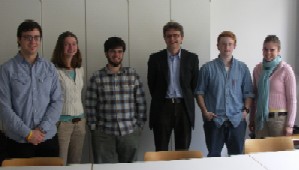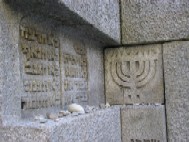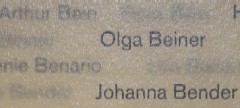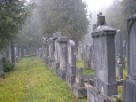Community, Memory, and Shifting Jewish Identities in Post-Wall Germany: The Case of Munich
Community, Memory, and Shifting Jewish Identities in Post-Wall Germany: The Case of Munich
 Prof. Rob Leventhal, with K.C. Tydgat ('07), Sam Thacker ('08), Ben Fontana ('09) and Olivia Lucas ('08)
Prof. Rob Leventhal, with K.C. Tydgat ('07), Sam Thacker ('08), Ben Fontana ('09) and Olivia Lucas ('08)
The "negative symbiosis" of post-war German-Jewish culture took a decisive turn in 1989 with the fall of the Wall and the almost immediate unification of Germany one year later. Based as it was on a specifically German-Jewish perspective and orientation, this prevailing reading of the situation of the Jews in Germany underwent a radical change with the simultaneous dissolution of the Soviet Union, and the Federal Republic's willingness to serve as a Zufluchtsort - a place of sanctuary - for over 200,000 Russian Jews over the next fifteen years. Munich became a destination of choice for many Russian Jewish émigrés, often even preferred to Israel and the United States. The utopistic promise of the reunification, the initial euphoria that followed 1990, the social welfare state of Germany, and the strength of the existing Jewish community in Munich all contributed to a powerful vision of future affluence, citizenship, cultural and social belonging and support that attracted thousands of Russian Jews to Munich.

By 1996-1997, however, this positive image of Germany and the optimistic sense of the Russian Jewish émigrés had changed radically. In a study published in 1999 based on data captured and analyzed in the preceding two years, the team of Julius Schoeps painted a very bleak picture indeed both of the current state of this community as well as its short and longer term prospects unless fundamental changes could be made, both by the Jewish Gemeinde, and the city, state and federal governments. Schoeps and his team pointed out that while fear of anti-Semitism had fallen since 1993-1996 (when it was at its height because of Mölln, Solingen, Heyerswerda and other quite vicious and very well-publicized attacks against foreigners, mostly by Neo-Nazi groups), there has been a dramatic increase in unemployment among the Russian Jewish émigrés, problems with integration into the work and housing market, insufficient and poor language instruction, increasing isolation and alienation, both from the existing Jewish Community and the German communities in which they were embedded, the sense of loss of both prior status and present perspective, feelings of dependence and hopelessness. Many respondents to their questionnaire indicated a kind of cultural collective depression.
 The situation for Russian Jewish émigrés in the Federal Republic of Germany has changed radically over the last two years. Most importantly, significant changes in the Federal Law concerning immigration have all but cut off the flow of Jewish émigrés from the former Soviet States. According to the new procedures and regulations of the German Immigration Law, there are essentially three classes of Jewish émigrés from the former Soviet States: there are those who placed an application to enter Germany prior to July 1, 2001, those who placed their immigration application between the July 1, 2001 and December 12, 2004; and those who placed their Einreiseantrag after the 12th of December, 2004.
The situation for Russian Jewish émigrés in the Federal Republic of Germany has changed radically over the last two years. Most importantly, significant changes in the Federal Law concerning immigration have all but cut off the flow of Jewish émigrés from the former Soviet States. According to the new procedures and regulations of the German Immigration Law, there are essentially three classes of Jewish émigrés from the former Soviet States: there are those who placed an application to enter Germany prior to July 1, 2001, those who placed their immigration application between the July 1, 2001 and December 12, 2004; and those who placed their Einreiseantrag after the 12th of December, 2004.

The new Zuwanderungsgesetz that went into effect January 1, 2005 replaced the HumMAG - the humanitarian assistance program or Kontigentsflüchtlingsgesetz - and made the following requirements prerequisites for a successful application for emigration into the FRG: 1) the person must be of Jewish "nationality", come from at least one Jewish person (mother or father, unlike the Jewish Law to which they are subject by the Einheitsgemeinde of Germany once they arrive), and have not been a member of any other religious community; 2) the applicant must be able to demonstrate knowledge of the German Language at least at the level of the GERR Level A1 (Gemeinsamer Europaischer Referenzrahmen für Sprachen); this condition is also obligatory for those members of the family seeking to enter Germany with the applicant; 3) they must receive a "positive Integrationsprognose" - meaning that they must be judged to have a likely positive integration process in Germany - from BAMF, and they must be able to show that they will be able to support themselves once in the Federal Republic; 4) they must demonstrate that they are capable of being accepted into a Jewish Community (Gemeinde) by the Zentralwohlfahrtstelle für Juden in Deutschland e.V. (ZWFST). The only exceptions to these conditions are the cases of clearly demonstrable victims of the Nazi persecution itself, in which case the Integrationsprognose by the ZWFST and the German Language proficiency requirements are dropped.
 The possibility of admitting more Russian Jewish émigrés has now been directly linked to ability and willingness of the Länder to support the GemeindeGemeinde. For the period after 2006, while there have been many negotiations among the four parties directly involved - the Auswärtiges Amt, the BAMF, the Zentralrat der Juden in Deutschland, and the Union Progressiver Juden - and supposedly some oral "financial commitments" have been made, as of this writing no actual fundsGemeinde. For the year 2005, no applications or Anträge for entry into the Federal Republic were accepted: "Die deutschen Botschaften und Konsulate in den Ländern der ehemaligen Sovietunion haben nach Auslaufen des ‘Kontingentverfahrens' am 31. Dezember 2004 schlichtweg keine Auswanderungsanträge mehr angenommen." Secondly, according to a recent article by Tobias Kuhn, "Die Integrationskasse ist leer." ("The integration account [the federal funds for the integration efforst of the Gemeinde] is empty."
The possibility of admitting more Russian Jewish émigrés has now been directly linked to ability and willingness of the Länder to support the GemeindeGemeinde. For the period after 2006, while there have been many negotiations among the four parties directly involved - the Auswärtiges Amt, the BAMF, the Zentralrat der Juden in Deutschland, and the Union Progressiver Juden - and supposedly some oral "financial commitments" have been made, as of this writing no actual fundsGemeinde. For the year 2005, no applications or Anträge for entry into the Federal Republic were accepted: "Die deutschen Botschaften und Konsulate in den Ländern der ehemaligen Sovietunion haben nach Auslaufen des ‘Kontingentverfahrens' am 31. Dezember 2004 schlichtweg keine Auswanderungsanträge mehr angenommen." Secondly, according to a recent article by Tobias Kuhn, "Die Integrationskasse ist leer." ("The integration account [the federal funds for the integration efforst of the Gemeinde] is empty."
 In 2003, on the 65th anniversary of Kristallnacht, then Federal President Johannes Rau helped lay the first stone of Jüdisches Zentrum Jakobsplatz - the Jewish Center at the Jakobsplatz - a massive architectural and cultural event that is now becoming the location for the new central Synagogue, the Jewish Museum of Munich, a Jewish Community Center, and a Jewish School. A plot to bomb the ceremony by members of a neo-nazi group was successfully thwarted. The Synagogue opened its doors on November 9, 2006, and the Jewish Museum will be inaugurated on March 22, 2007. While some observers claim that such physical demonstrations of culture merely "externalize" or "displace" the deeper cultural conflicts, and many German Jews remain highly skeptical of a "reemergence of Jewish culture,"
In 2003, on the 65th anniversary of Kristallnacht, then Federal President Johannes Rau helped lay the first stone of Jüdisches Zentrum Jakobsplatz - the Jewish Center at the Jakobsplatz - a massive architectural and cultural event that is now becoming the location for the new central Synagogue, the Jewish Museum of Munich, a Jewish Community Center, and a Jewish School. A plot to bomb the ceremony by members of a neo-nazi group was successfully thwarted. The Synagogue opened its doors on November 9, 2006, and the Jewish Museum will be inaugurated on March 22, 2007. While some observers claim that such physical demonstrations of culture merely "externalize" or "displace" the deeper cultural conflicts, and many German Jews remain highly skeptical of a "reemergence of Jewish culture,"
This Student-Faculty Research Project explores this significant reconstruction and reemergence in Munich as a cultural and social event that is saturated with historical meaning and rife with conflicted and conflicting views, both for the German Jews and DPs of the first and second generation and the Russian Jewish émigrés who have arrived since 1989. Through close study of the recent research, literature and journalism, close tracking of the history of this emergence, on-site interviews with key literary, historical, and community figures, and an interpretive analysis of the structures themselves in their historical, social, and cultural contexts, GRMN 411 has attempted to a understand what precisely is at stake in this reconstruction, how it is being interpreted and used, how it is being perceived and appropriated.
This student-faculty research seminar GIS enabled students to explore and research a contemporary historical event in its actual real-time unfolding, uncover the historical and cultural forces at play in this unfolding, and present original work suitable for presentation and /or publication. The first pilot paper was presented at the German Studies Association Conference in San Diego in October, 4-7 2007.
The resultant article will appear in January 2011:
“Community, Memory, and Shifting Jewish Identities: The Case of Munich, 1989 to the Present,” Journal of Jewish Identities, Special Issue: Russian-Jewish Immigrant Identity Post 1970, Vol. 3, No. 2 (Fall, 2010).
Dan Diner, "Negative Symbiosis. Deutsche und Juden nach Auschwitz" Babylon 1 (1986): 9-20. This view has been echoed and amplified by many, including Sander Gilman, "German Reunification and the Jews," New German Critique (1991): 173-191 and Katja Behrens, "The Rift and not the Symbiosis," in: Unlikely History: The Changing German-Jewish Symbiosis (London: Palgrave, 2002): 32-43.
Julius Schoeps, Willi Jasper, Bernhard Vogt, "Jüdische Zuwanderer aus der GUS-Zur Problematik von sozio-kultureller und generationsspezifischer Integration" in: Ein neues Judentum in Deutschland? Fremd- und Eigenbilder rusiisch-jüdischer Einwanderer (Potsdam: Verlag für Berlin-Brandenburg, 1999): 13-139.
See James E. Young, The Texture of Memory (New Haven: Yale University Press, 1999), p.5 and his article "The Topography of Germany Memory, " The Journal of Art (March, 1991), where he argues that the more memory is externalized in monuments and actual physical buildings/structures, the less it, and its conflicts and ambivalences, are experienced internally.
This skepticism is extremely widespread, expressed by literary authors, cultural critics, historians, and public figures alike. See especially: Micha Brumlik, Kein Weg als Deutscher und Jude (Munich: Luchterhand, 1996); Rafael Seligmann, "Nicht in jüdischer Macht," Die Zeit Nov. 25, 1999; Y. Michal Bodemann, "A Reemergence of Jewish Life?" in: Reemerging Jewish Culture in Germany: Life and Literature since 1989 (New York/London: NYU Press, 1994) 47-60.
 Skip to main content
Skip to main content
